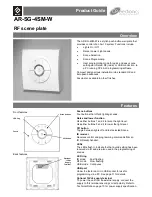
B2: Acceleration
4.2 Functions
Basic Functions
Function Manual, 09/2011, 6FC5397-0BP40-2BA0
241
4.2.17.2
Parameterization
The excessive jerk for block transitions without constant curvature is parameterized using the axis-specific
machine data:
MD32432 $MA_PATH_TRANS_JERK_LIM
(excessive jerk for block transitions without constant curvature)
4.2.18
Velocity-dependent jerk adaptation (axisspecific)
Function
When machining workpieces with free form surfaces, jerk limiting of an access frequently plays an important role:
As a result of fluctuations in the change of curvature of the workpiece to be machined, limiting the jerk of all of the
axes involved can cause fluctuations in the machining rate in the upper velocity range. These fluctuations in the
path velocity can have a negative impact on the quality of the surface being machined. These effects can be
avoided using the "velocity-dependent jerk adaptation" function.
Availability
The "velocity-dependent jerk adaptation" function is available independent of the function "Free-form surface
mode: Basic functions [Page 193]".
Parameter assignment
The "Velocity-dependent jerk adaptation" function is activated and configured for each specific axis using
machine data:
• MD32437 $MA_AX_JERK_VEL0[<n>]
Velocity threshold for the linear increase in the jerk adaptation.
The velocity threshold $MA_AX_JERK_VEL0 can be separately set for each dynamic mode (see "Dynamic
response mode for path interpolation [Page 191]"):
• MD32438 $MA_AX_JERK_VEL1[<n>]
Velocity threshold, from which the maximum jerk of an axis reaches the maximum value defined using factor
MD32439 $MA_MAX_AX_JERK_FACTOR.
The velocity threshold $MA_AX_JERK_VEL1 can be separately set for every dynamic mode analog to
$MA_AX_JERK_VEL0.
Index <n>:
Velocity threshold for the dynamic mode:
0
Standard dynamic response settings (DYNNORM)
1
Positioning mode, tapping (DYNPOS)
2
Roughing (DYNROUGH)
3
Finishing (DYNSEMIFIN)
4
Smooth-finishing (DYNFINISH)















































